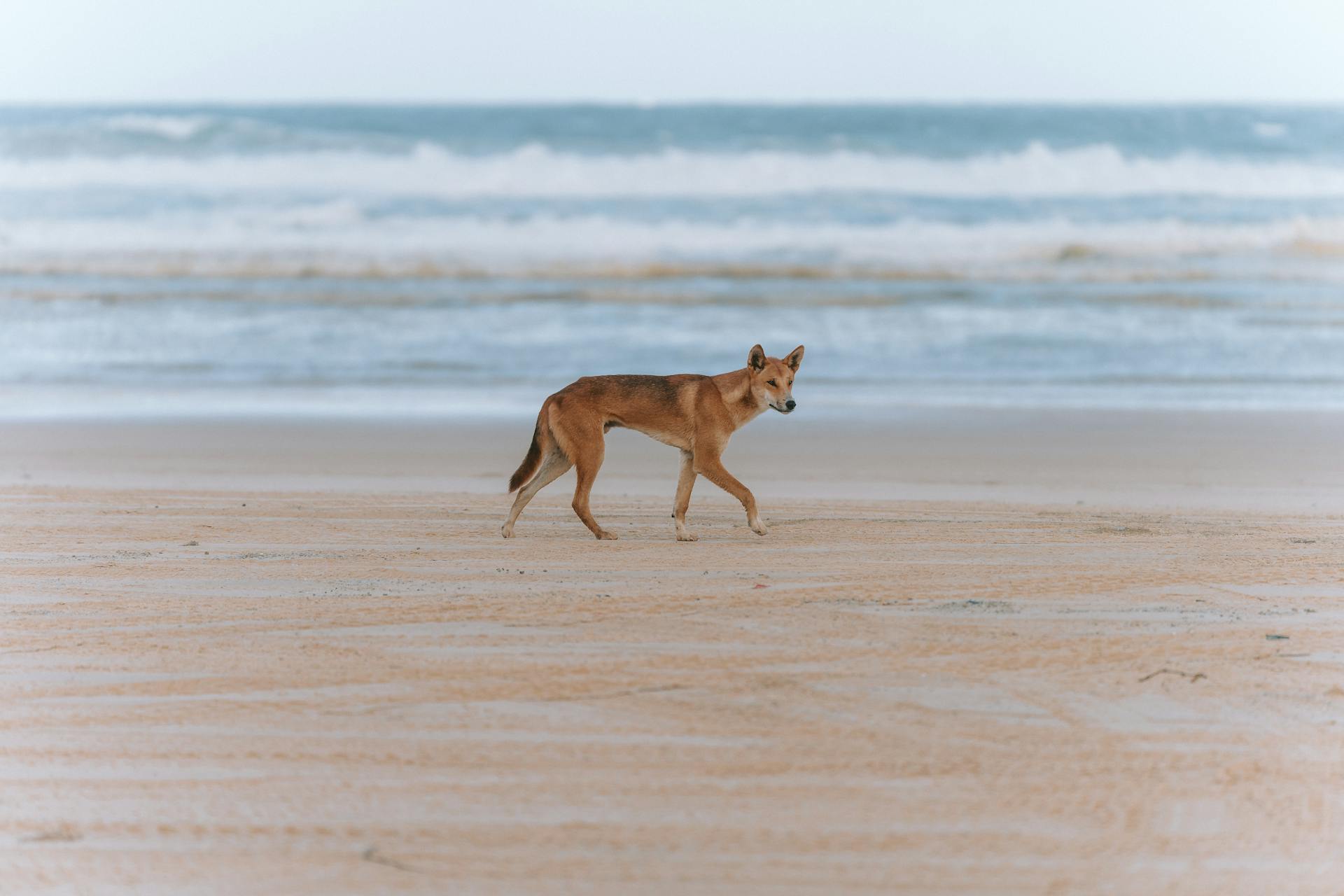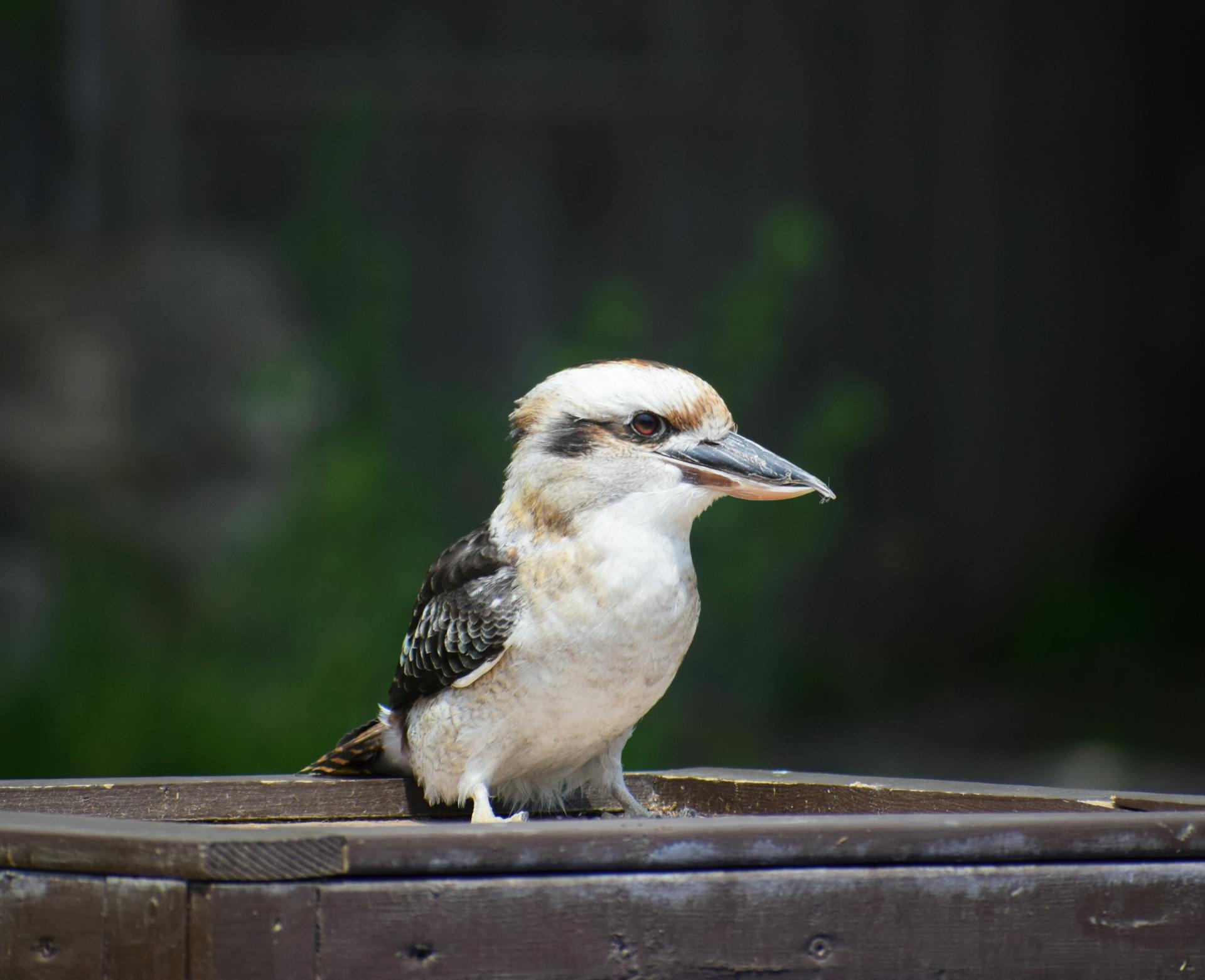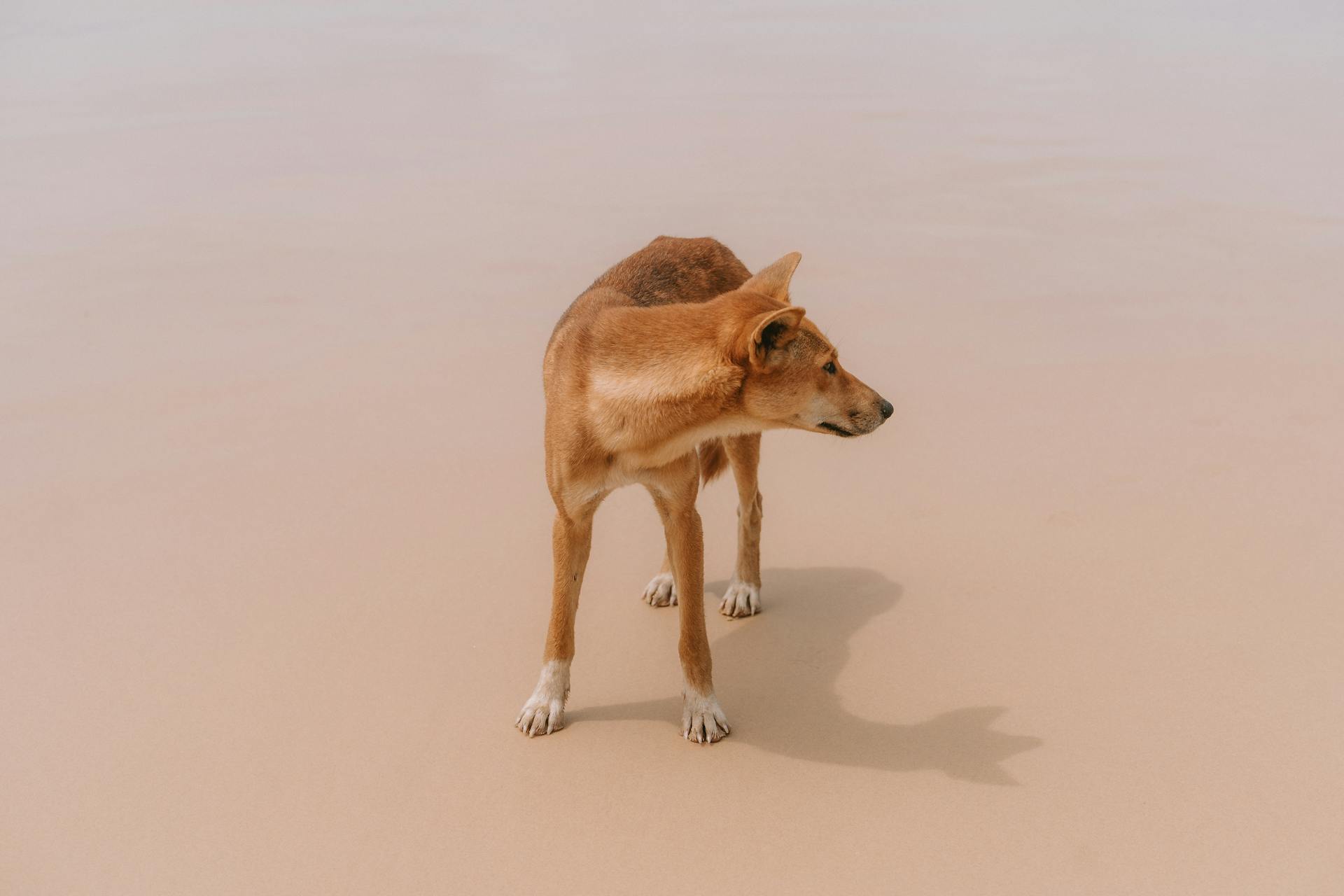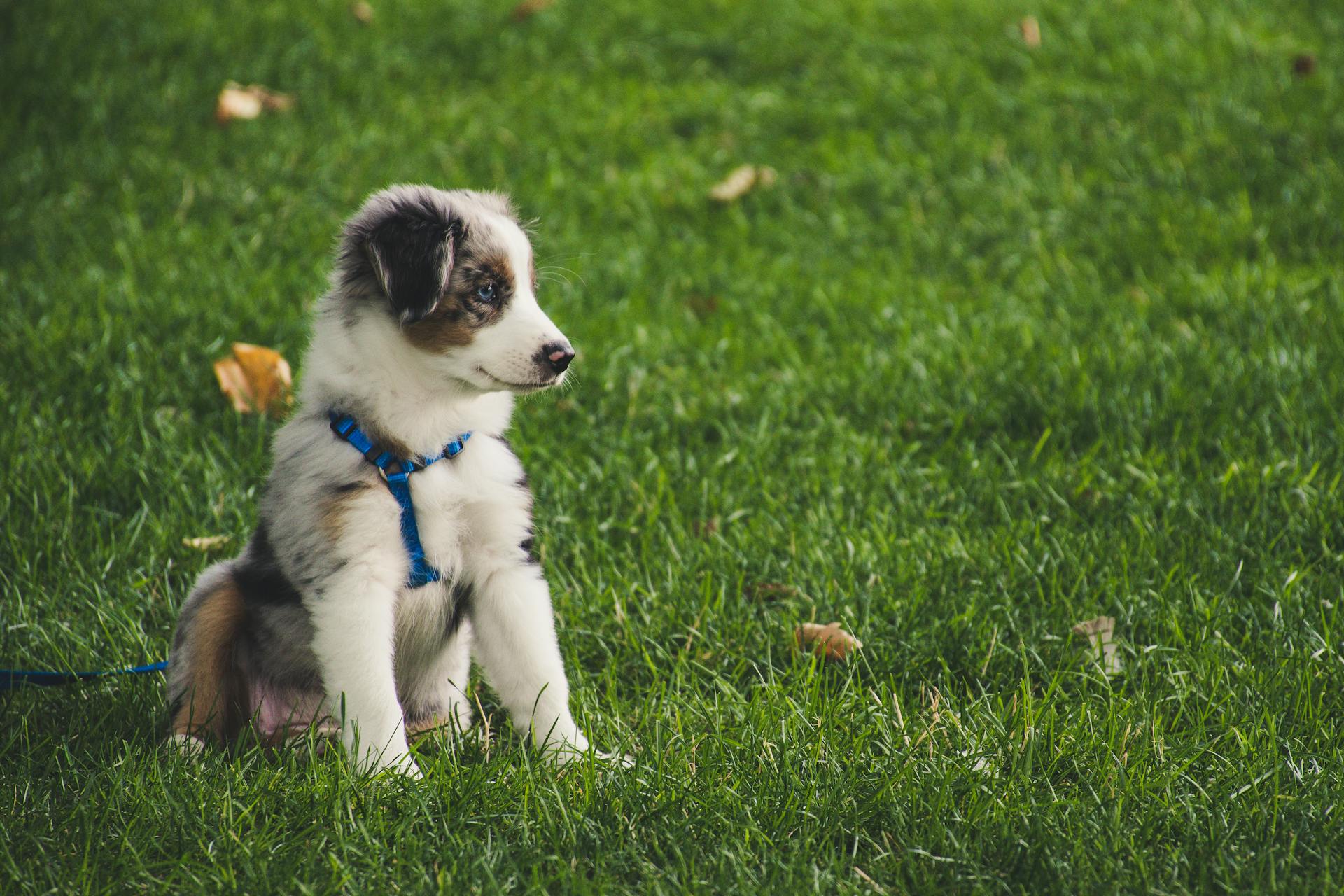
The Australian Dingo is a fascinating creature that has adapted to its harsh environment over thousands of years. They are a unique and ancient breed that is found in the wild.
The dingo's physical characteristics are well-suited to their habitat. They have a lean body, short coat, and a bushy tail that helps them regulate their body temperature in the hot Australian climate.
One of the most distinctive features of the dingo is their ability to survive in a variety of habitats, from deserts to forests. They are highly adaptable and can be found in a range of environments, from the arid Outback to the coastal regions of Australia.
In the wild, dingos are highly social animals that live in packs. These packs are usually made up of a dominant male and female, along with their offspring.
You might enjoy: Australian Wild Dog
Physical Characteristics
The Australian Dingo's physical characteristics are quite fascinating. The Dingo is a placental mammal, which means it gives birth to live young and feeds its young via mammary glands that produce milk.

Its fur is short and can vary in color depending on its habitat. In desert areas, the fur is more golden yellow, while in forested areas, it can be a darker tan to black. The standard coat color is ginger with white feet.
The Dingo's body length is typically around 3.5 to 4 feet, with the tail adding another 12 to 13 inches to its length. Males are usually larger than females, weighing between 22 to 33 pounds.
Here's a summary of the Dingo's physical characteristics:
What Does It Look Like?
The Dingo's appearance is quite distinctive, with a dog-like face and erect ears. Its body fur is short, while the tail is quite bushy.
Its coat color is determined by its living environment, ranging from a standard ginger with white feet to a darker tan to black in forested areas.
Dingoes are Australia's largest mammal carnivores, with canine teeth longer than those of a domestic dog.
Their muzzle is longer and tapered, adding to their unique appearance.
Here are some key measurements to help you visualize a Dingo's size:
Most Dingoes are a reddish-orange color, although some rare individuals can be black and white or black and tan.
Consider reading: Australian Black Dingo
Molecular and Cellular Traits
Dingoes have a unique genetic makeup that sets them apart from domestic dogs. Alan Wilton's groundbreaking research on dingo genetics laid the foundation for assessing genetic purity.
The frequency of microsatellite markers is used to determine dingo purity, comparing alleles to those found in captive and wild dingoes and domestic dogs. This comparison establishes the probability of a dog being a pure dingo.
A simulated dog-dingo hybrid is used to compare the allelic genotype of the tested canine, with the final scoring taking into account the presence or absence of alleles found only in domestic dogs.
The Alpine Dingo, named Typia, was bred in a colony and may be more inbred than wild dingoes, but is likely a pure Alpine due to the focus of the Bargo sanctuary on dingoes found in SE Australia.
Where Does It Live?
Dingoes live throughout western and central Australia in forests, plains, mountainous rural areas, and desert regions.
They make their dens in rabbit holes, caves, or hollow logs, often close to a water source. This preference for woodland and grassland areas that extend to the edge of forests is a key characteristic of their habitat.
Dingoes can be found in a wide range of habitats on the Australian mainland, from deserts to tropical rainforests, but they are limited by access to viable water sources.
Their range has been reduced due to the introduction of agriculture by early European settlers and the fear of predation of livestock, which saw their range reduced.
Dingoes are mostly absent from many parts of New South Wales, Victoria, the south-eastern third of South Australia, and from the southern-most tip of Western Australia, but they are regarded as common throughout the remainder of Australia except in the arid eastern half of Western Australia, nearby parts of South Australia, and the Northern Territory.
They have been in Australia for around 4,000 years and never reached Tasmania, where they are still absent today.
Check this out: Australian Shepherds Water Dogs
Diet and Nutrition
Dingoes are carnivores and have a very varied diet ranging from insects to water buffalo. They are opportunistic feeders and will hunt anything including geese, wallabies, kangaroos, lizards, rabbits, mice and rats.
A typical meal for a dingo includes a rodent, rabbit, bird or lizard, according to National Geographic.
Dingoes will hunt alone when stalking small prey and in packs when targeting large prey. They will also scavenge carrion (dead animal carcasses) and eat fruit and plants.
Small to medium game is usually what's on the menu for dingoes. They are very efficient hunters and can adapt to different food sources.
Dingoes are known to eat reptiles and any food source they can find including insects and birds. Scavenging at night, the Dingo is a solitary hunter but will form larger packs when hunting bigger game.
The main part of a dingo's diet are mammals, especially rabbits, kangaroos, wallabies and wombats.
Behavior and Adaptations
Dingoes are highly territorial animals, often defending their territory against other Dingoes, but will share it when forming packs for hunting. They tend to stay within their defined territory, rarely venturing out.
Dingoes rarely bark, instead using howls to communicate, particularly at night to attract pack members or ward off intruders. Their howls can be heard over long distances.
They also use scent-rubbing, defecating, and urinating to mark territorial boundaries, leaving their scent on objects like grass tussocks.
Behaviours and Adaptations
Dingoes are highly territorial animals, with a clearly defined territory that they rarely leave and often defend against other dingoes.
However, they're not opposed to sharing their territory when they form packs for hunting.
They tend to howl at night to attract pack members or ward off intruders, rather than barking like their canine cousins.
Dingoes also use scent-rubbing, defecating, and urinating on objects to mark territorial boundaries.
In fact, they're very vocal animals, with three basic howls and over 10 variations.
A group of dingoes is called a pack, which can consist of 3-12 individuals, each with a dominant male and female leader.
These leaders are determined through aggressive stand-offs, showing just how competitive dingoes can be.
Despite their territorial nature, dingoes choose their territories based on environmental factors like terrain texture and prey availability.
In the south of Australia, for example, dingoes tend to have larger ranges than those in the north.
Dingoes are also very intelligent and independent, making them more challenging to train than domestic dogs.
However, some people do keep dingoes as pets, despite their independent nature.
Breeding Behaviours
Dingoes typically become sexually mature at a relatively young age, with females reaching maturity by 2 years and males by 1 year. This early maturity allows them to quickly establish themselves in their social hierarchy.
Only the most dominant members of an established Dingo pack will breed, leaving other members to focus on caring for the pups. This social structure is a key aspect of Dingo behavior.
Dingoes can interbreed with other breeds of domestic dogs, which has led to some interesting genetic variations in their populations.
Life Cycle and Reproduction
Australian Dingoes breed once a year between March and June, with a gestation period of approximately nine weeks.
Both parents are involved in rearing their young in a hollow log, rock shelter, old rabbit warren or wombat burrow. Weaning of the pups occurs at about two months.
Dingo pups are fully grown by seven months of age and adult Dingoes can live for up to ten years.
Life History

Dingoes typically breed once a year between March and June.
The gestation period for Dingoes is approximately nine weeks, similar to domestic dogs.
A litter of four to six pups is usually produced during this time.
Both parents are involved in rearing their young in a sheltered location such as a hollow log or burrow.
Weaning of the pups occurs at about two months, at which time they may be abandoned or can stay with the parents for about a year.
Dingo pups are fully grown by seven months of age.
Adult Dingoes can live for up to ten years.
Reproduction
Dingoes typically breed once a year, between March and June, with a gestation period of approximately nine weeks.
Both parents are involved in rearing their young, which usually consists of four to six pups. The pups are weaned at about two months and may be abandoned or stay with the parents for about a year.

Adult Dingoes can live for up to ten years.
Female pack members help feed the young by regurgitating food and water for the pups, while males scent mark more than females during the breeding season.
Breeding season occurs once a year, like wolves but unlike domestic dogs, and is restricted to the dominant pair of a pack.
Dingoes reach sexual maturity at 2 years for females and 1 – 3 years for males, with alpha females entering estrous once a year for 10 – 12 days.
Pups are weaned onto solid foods at 8 weeks and become independent at around 3 – 6 months, remaining with the pack for 12 months.
The alpha female is known to kill the pups of other female members of the pack to ensure that the dominant animals will pass on their genes to the next generation.
Dingoes live between 5 and 10 years in the wild and up to 15 years or more in captivity.
Baby dingoes are called pups and are born after a gestation period of around 63 days, typically in a maternal cave or burrow.
At 3 years, the pups find a mate and often mate for life, according to ADW.
Dingoes typically live around 13 years.
A unique perspective: How Long Do Australian Labradoodles Live
Frequently Asked Questions
Do Australian dingoes make good pets?
Dingoes can make loyal companions, but their strong instincts and potential aggression may not make them suitable as pets for everyone
Is A dingo aggressive?
Dingoes are generally non-aggressive, but can become aggressive in certain situations. They are naturally wary of humans, but negative interactions have been recorded.
Is a dingo an Australian wolf?
No, a dingo is not an Australian wolf, but rather an intermediate species between wolves and domestic dogs, as revealed by recent DNA sequencing. This unique classification makes the dingo a fascinating subject for further exploration.
Is a dingo just a dog?
Dingos are a topic of debate among scientists, with some considering them a domestic dog, a subspecies of dog or wolf, or a full species in their own right. Their taxonomic classification is still being researched and discussed
What are 5 interesting facts about dingoes?
Dingoes are unique animals that howl and vocalize in various ways, have a diverse diet, and live in strict social hierarchies. They also mate for life and have a distinct annual breeding cycle, making them fascinating creatures to learn more about.
Featured Images: pexels.com

